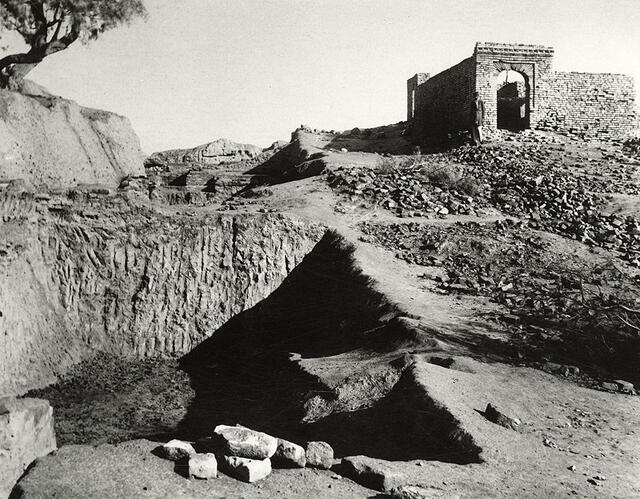
Harappa Trench B 1923-24
This section presents the photographs from excavations led by Daya Ram Sahni in 1923-24.
Sahni published his brief report in the Annual Report Of The Archaeological Survey Of India 1923-24 in 1926. Many of the photographs published with his report are included in the slides here. Some of the photographs were also published in Madho Sarup Vats' monograph Excavations at Harappa: Being an account of archaeological excavations at Harappa carried out between the years 1920-21 and 1933-34. Volume I - Text; Volume II - 139 Plates.
To find out more about the excavation in the 1923-24 season, visit our description of The Second Season of Excavations at Harappa Conducted by Daya Ram Sahni 1923-24.
This section has approximately 60 photographs associated with the excavations at Harappa in the 1923-24 season. These appear in slideshow format in the 49 slides, with similar or closely related photographs of an object grouped together. The photographs include views of the mounds before they were cut into, the sections of the excavated trenches often with objects in situ, and images of objects after they had been cleaned and catalogued. This broad range of visuals available required us (at Harappa.com) to take some decisions about how to present this information in a way that provides some wider context without detracting from each image individually. To this end, we have loosely organised this visual narrative following the way Sahni presented the material in his 1923-24 report. This is done as follows: the first part of the series looks at Mound F, including images of its surface, trenches, excavation and the objects found there, we then do the same for Mound A-B, followed by smaller Trench E. To orient the viewer, we include maps for each of these areas Vats' monograph that situate the mound within the Harappan excavations, and we also insert plans and elevations where pertinent and referenced in the associated text. Our aim is to convey the sense of discovery as well as the unknown that would have prevailed in these initial seasons of excavation.
The role of these early records and photographs cannot be emphasised enough. Archaeological excavation by its nature and definition is considered inherently destructive. In fact, the word excavation derives from the Latin word excavo, which means to hollow out. The process of cutting into soil and, albeit systematically, moving and removing what is encountered changes the site. “Every archaeological site is itself a document. It can be read by a skilled excavator, but it is destroyed by the very process which enables us to read it. Unlike the study of an ancient document, the study of a site by excavation is an unrepeatable experiment."(Barker 1993:13) This is where these photographs become such a critical and vital source of information, offering us the possibility to see, once again, what the archaeologists saw and how the discoveries progressed. But these photographs should not be read as objective documentation. Everything that is recorded about an excavation in writings, drawings and photographs comes from the decisions and approaches of the people who are involved. As Roosevelt et al. note, "excavation is seen as displacement, a material intervention, and a form of archiving that incorporates an excavator's approaches, interpretations, and biases into the archive itself, with the implicit understanding that the archaeological record becomes subjective as soon as archaeologists engage with it." (Roosevelt et al. 2001:325)
These photographs from the Archaeological Survey of India (ASI) that we are curating season by season from the excavations at Harappa, not only offer a fascinating glimpse into what the people working at the site of Harappa saw, and worked through, but also provide insights into the methods and approaches that were being used, revised and improved, both for excavating the site and in the use of photography in archaeology. These images also reveal to us things that the written archive sometimes renders invisible, but the camera has captured in the moment - the faces and stances of the local workers, the archaeologist looking out over the mounds, the trees, shadows and dust that form the landscape. Off-site, in the photographs of the artefacts, we can start to see how the archival record and its methods are developing, with information about scales and lighting incorporated, and corrections made when a figurine is inadvertantly pictured upside down!
We hope that this visual journey through the 1923-24 discovery of Harappa as recorded in the Archaeological Survey of India photographs will offer you new insights and help you understand more about this remarkable site and the process of its discovery.
- Dr. Nadine Zubair
References:
Barker, P. (1993) Techniques of Archaeological Excavation (third edition). London: B.T. Batsford
Christopher H. Roosevelt, Peter Cobb, Emanuel Moss, Brandon R. Olson & Sinan Ünlüsoy (2015) Excavation is Destruction Digitization: Advances in Archaeological Practice, Journal of Field Archaeology, 40:3, 325-346, DOI: 10.1179/2042458215Y.0000000004
Vats, M. S. (1940) Excavations at Harappā. Being an Account of Archælogical Excavations at Harappā Carried Out between the Years 1920-21 and 1933-34 Etc. [with Plates Including Maps.]. Calcutta: Government of India Press.
